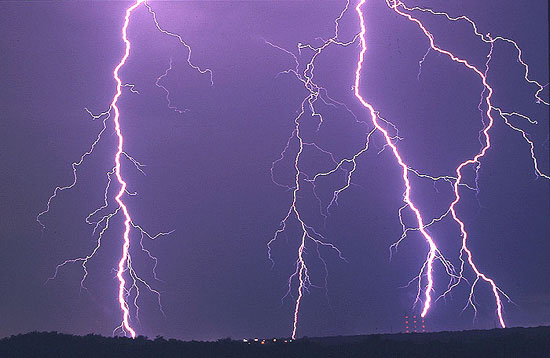
Expert Systems 9501 Tinker Court Burke , VA 22015
|
Expert Systems 9501 Tinker Court Burke , VA 22015
|
ISOLATION OF
PERSONNEL SAFETY The guaranteed safety of personnel working in a High Voltage Area, particularly a PCS location within a High Voltage Corridor cannot be obtained whether the serving facility is fiber or copper. This is due to the very high step and touch potentials that may occur at PCS locations, within a High Voltage Corridor, during a Ground Potential Rise (GPR) incident. To improve safety, personnel working at PCS locations, within High Voltage Corridors, must always work while standing on a 20kV or greater isolating rubber blanket, wear isolating rubber gloves and boots. Personnel must also keep a watchful eye on the weather conditions and leave the area at the first sign of approaching bad weather or lightning. To achieve the highest possible personnel safety and least reoccurring exposure to harm, passive (requiring no power) isolation equipment for these facilities should be considered. Passive isolation on an average is six times more reliable than active (requiring power) isolation.
SERVICE RELIABILITY The highest service reliability may actually be from wire-line facilities using passive isolation equipment, i.e., isolation transformers. Active isolation equipment using optical isolators requiring power will lower the reliability of a T1 Carrier or HDSL service and needlessly expose maintenance personnel more frequently, to possible harm. The fewer service calls that have to be made, the less exposure there will be to personnel being subjected to a GPR incident. Not being there during a GPR incident is the safest of all worlds.
HIGH VOLTAGE CORRIDORS Isolation equipment is readily available that will protect wire-line communication facilities entering PCS locations within High Voltage Corridors. Properly installed, this equipment will offer many years of maintenance free reliable service from the effects of a GPR. Ironically, one of the most serious threats to wire-line communications facilities is not from GPR but from induction due to paralleling the power entrance facility serving the same PCS location. The neutral and ground wire of the power entrance facility will carry significant current away from this location if there is a GPR incident. In designing the wire-line communications entrance facility, parallel the power entrance facility as little as possible (not more than 200 feet) and maintain as great a separation (50 plus feet) as possible. This will minimize induced voltage on the wire-line communications entrance facility. PCS locations within High Voltage Corridors that have Overhead Ground Conductors (OGC) with no neutral will experience theoretical GPR levels less than 45KV Peak-Asymmetrical, provided that the PCS grounding system is less than 5 ohms. If a neutral is also present in the overhead the theoretical GPR levels will then be less than 20kV Peak-Asymmetrical. These levels of GPR can easily be isolated using passive isolation equipment. This represents a vast majority of the type of High Voltage Corridors in use. PCS locations within High Voltage Corridors that have no OGC and no neutral, will experience much higher theoretical GPR levels even with a 5 ohm PCS grounding system at the tower base. This is because all of the fault energy will pass down through this single tower into the ground. Worst case theoretical GPR levels under these conditions could reach a maximum of 85kV Peak- Asymmetrical. However, actual GPR levels much over 30kV Peak-Asymmetrical may not be realistic because of earth ionization. Consideration should be given to not using these corridors (no OGC and no Neutral) at all, if these theoretical levels of GPR are stood by the providing engineers as possible levels. If these theoretical GPR levels were ever reached, though very doubtful, even nominal safety for working personnel in the area may be difficult because of step and touch potentials.
REALITY CHECK Theoretical GPR calculations from possible faults at tower bases within High Voltage Corridors have been provided to telephone companies that are enormous. Some calculations have shown potential GPR to be higher than the driving voltage in the line. In one case a GPR of 408kV was derived from a 230kV transmission line. Obviously this is ridiculous and shows that calculations developed by multiplying numbers together can produce anything. Without actual GPR fault data, reliance on responsible theoretical calculations is a must. Power and telephone utilities must work together in providing these types of services. Unreasonable GPR calculations result in frustration, delays, additional costs, and possibly choosing an option that may be less reliable and therefore more hazardous to maintenance personnel over the life of the facility. Responsible coordination, cooperation, and honest effort will jointly produce results that can be relied upon in providing the most economical facility design without sacrificing the safety and reliability of a future PCS antenna site.
New! Lightning Protection Checklist for Risk Management New ! Lightning Protection Guide for protecting equipment and personnel New ! Lightning Storm Dot Com view the current lightning map of the United States New ! Lightning and GPR Related Links New ! Lightning Related Articles New ! Lightning Related Reference Books New ! Wire-Line Communications Isolation or Fiber Optic Facility Extensions ? Solving High Voltage Problems In Wireless/Utility Collocations Eliminating Lightning Damage at PCS Cell Sites Isolation of Wire-line Communications in an Unregulated Power Market PCS Locations in High-Voltage Corridors Be alert to the Danger of GPR On the Road With Ernie Great Balls of Fire! Destructive Surges Wireline Isolation Theory and Application When to Protect Cell Sites from GPR Links to US Energy Utilities Communications Related Links Return to GPR Expert Home
|